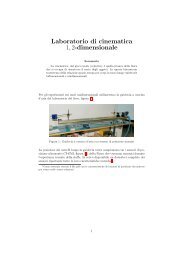Newton's law of cooling revisited - Cartan
Newton's law of cooling revisited - Cartan
Newton's law of cooling revisited - Cartan
Create successful ePaper yourself
Turn your PDF publications into a flip-book with our unique Google optimized e-Paper software.
Newton’s <strong>law</strong> <strong>of</strong> <strong>cooling</strong> <strong>revisited</strong> 1075<br />
(a) (b)<br />
Figure 7. Computed <strong>cooling</strong> curve for combined convection and radiative <strong>cooling</strong>. For temperature<br />
differences below 100 K, a simple exponential fit, i.e. Newton’s <strong>law</strong>, is a reasonable approximation<br />
(a). Such <strong>cooling</strong> curves can usually be approximated by a second- or third-order exponential fit<br />
(b), the first contribution <strong>of</strong> which will be dying <strong>of</strong>f before �T decreases below 100 K.<br />
Figure 8. Difference between theoretical <strong>cooling</strong> curve computed from equation (10) (for ε = 0.9,<br />
40 mm size Al cubes and αConv = 10 W m −2 K) and the third-order exponential fit (parameters<br />
T0 = 0.072 K, A1 = 281.06 K, τ 1 = 1009.72 s, A2 = 253.27 K, τ 2 = 297.04 s, A3 = 162.25 K and<br />
τ 3 = 78.68 s).<br />
will dominate and describe the <strong>cooling</strong> curve. This means that Newton’s <strong>law</strong> <strong>of</strong> <strong>cooling</strong> is<br />
always an appropriate description for adequately long times. Unfortunately, the adequate time<br />
interval and the respective relevant critical temperature difference depend on the experimental<br />
conditions and must be evaluated each time. One example: <strong>cooling</strong> water with �T < 50 K in<br />
beakers usually follows Newton’s <strong>law</strong>.<br />
We finally note that when using a simple exponential and explaining this with equation (9),<br />
one usually assumes a single coefficient for the heat transfer which is very <strong>of</strong>ten misleadingly<br />
called the convective heat-transfer coefficient, although it represents a combination <strong>of</strong><br />
convection and radiation.<br />
6. Experiments<br />
A number <strong>of</strong> different objects were studied experimentally for variable conditions. First,<br />
liquids in bottles or cans were cooled in fridges, freezers or air convection coolers. With these




